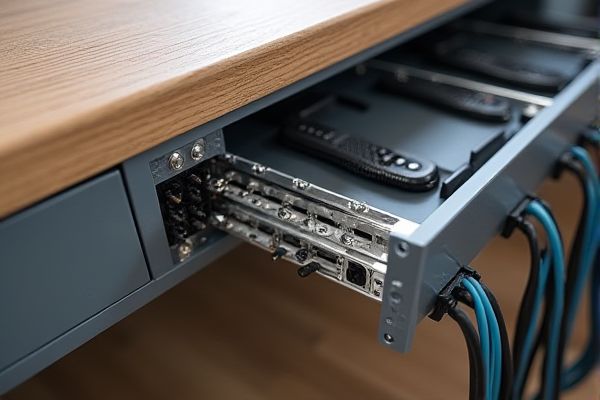
Cable management trays provide a sturdy, organized platform for holding multiple cables neatly in place beneath desks or along walls, reducing clutter and improving airflow. Your choice between trays and hook systems depends on whether you prioritize maximum load capacity or easy access; explore the rest of the article to find the best solution for your setup.
Table of Comparison
| Feature | Cable Management Tray | Hook System |
|---|---|---|
| Purpose | Organizes and supports multiple cables in a structured manner | Holds individual cables or small bundles using hooks |
| Capacity | High - accommodates large cable bundles | Low to medium - designed for fewer cables |
| Installation | Fixed under desks or ceilings, often requires tools | Simple, clip or adhesive-based, easy to reposition |
| Flexibility | Less flexible once installed; supports heavy cables | Highly flexible with easy adjustments |
| Visibility | Conceals cables for cleaner appearance | Cables remain visible but organized |
| Cost | Moderate to high | Low to moderate |
| Ideal Use Case | Data centers, offices with extensive cabling | Home offices, small setups, or quick cable routing |
Introduction to Cable Management Solutions
Cable management trays provide a sturdy, horizontal platform ideal for organizing multiple cables in server rooms or workstations, improving airflow and reducing clutter. Hook systems offer flexible, quick access to individual cables, making them suitable for environments where frequent changes or adjustments are necessary. Your choice depends on the need for permanent organization or adaptable cable routing in your network infrastructure.
What is a Cable Management Tray?
A cable management tray is a rigid, often metal or plastic structure designed to support and organize multiple cables along walls or under desks, providing a clutter-free and safe environment. Unlike hook systems, which hang cables individually, trays group cables neatly in a flat or channel-like formation, preventing tangling and allowing easy access for maintenance. These trays improve airflow around cables, reducing heat buildup and enhancing overall cable lifespan and system reliability.
Understanding Hook Systems for Cable Organization
Hook systems for cable organization provide versatile and easily adjustable support for your cables, enabling quick access and efficient routing along desks or walls. Unlike cable management trays that offer enclosed pathways mainly for bulk cable storage, hooks secure individual cables, reducing clutter and preventing tangling. Choosing a hook system enhances flexibility in managing varying cable sizes and improves airflow, which can prevent overheating in electronic setups.
Installation Process: Tray vs. Hook System
The installation process of a cable management tray involves securely mounting a rigid structure beneath desks or along walls, requiring precise measurements and tools for anchoring brackets and securing cables inside the tray. In contrast, hook systems offer a more flexible and quicker setup by simply attaching hooks to surfaces, allowing cables to hang freely without the need for extensive hardware or complex assembly. Your choice depends on whether you prioritize a sturdy, concealed solution with trays or a fast, adjustable option with hooks.
Capacity and Load Handling Differences
Cable management trays offer higher capacity and superior load handling capabilities compared to hook systems, making them ideal for supporting heavy cable bundles in data centers or industrial environments. Hook systems are better suited for lighter cables and smaller bundles, as their design limits weight distribution and overall load capacity. Choosing the appropriate system ensures your cables are securely supported, preventing damage and maintaining organization.
Flexibility and Adaptability Comparison
Cable management trays offer enhanced flexibility by allowing easy rearrangement and addition of multiple cables in diverse configurations, supporting various cable sizes and quantities. Hook systems provide adaptability through simple attachment and detachment of individual cables, ideal for quick access and dynamic changes in cable layout. Trays excel in structured organization for high-density setups, while hooks suit environments requiring frequent cable modifications or temporary installations.
Maintenance and Accessibility Considerations
Cable management trays offer superior accessibility by allowing easy access to cables for maintenance and troubleshooting, reducing downtime in data centers or office environments. Hook systems provide a simpler installation but can hinder quick access during maintenance due to their less organized cable arrangement. Proper selection depends on the need for frequent cable adjustments and the importance of maintaining a clean and efficient workspace.
Durability and Material Choices
Cable management trays typically offer higher durability due to their solid metal or heavy-duty plastic construction, providing reliable support for heavier cable bundles in industrial or office settings. Hook systems, often made from lighter materials like plastic or thin metal, provide flexibility but may wear out faster under constant load or environmental stress. Your choice should consider material strength and intended usage to ensure long-term performance and minimal maintenance.
Cost-Effectiveness: Tray vs. Hook System
Cable management trays generally offer higher cost-effectiveness for large-scale installations due to their durability, capacity, and ease of maintenance, reducing long-term expenses. Hook systems typically incur lower initial costs but may require frequent adjustments and replacements, increasing overall expenditures in complex or expanding setups. Choosing between trays and hooks depends on balancing upfront investment with anticipated maintenance and scalability needs.
Choosing the Right Cable Management System for Your Needs
Choosing the right cable management system depends on the scope and complexity of your wiring setup; cable management trays offer robust support for heavy bundles and allow for easy organization and maintenance in server rooms or data centers. In contrast, hook systems provide flexible, cost-effective solutions ideal for lighter cabling in home offices or simpler environments, enabling quick adjustments and additions. Evaluating factors such as cable volume, weight, accessibility, and future expansion ensures optimal performance and safety.
 homyna.com
homyna.com